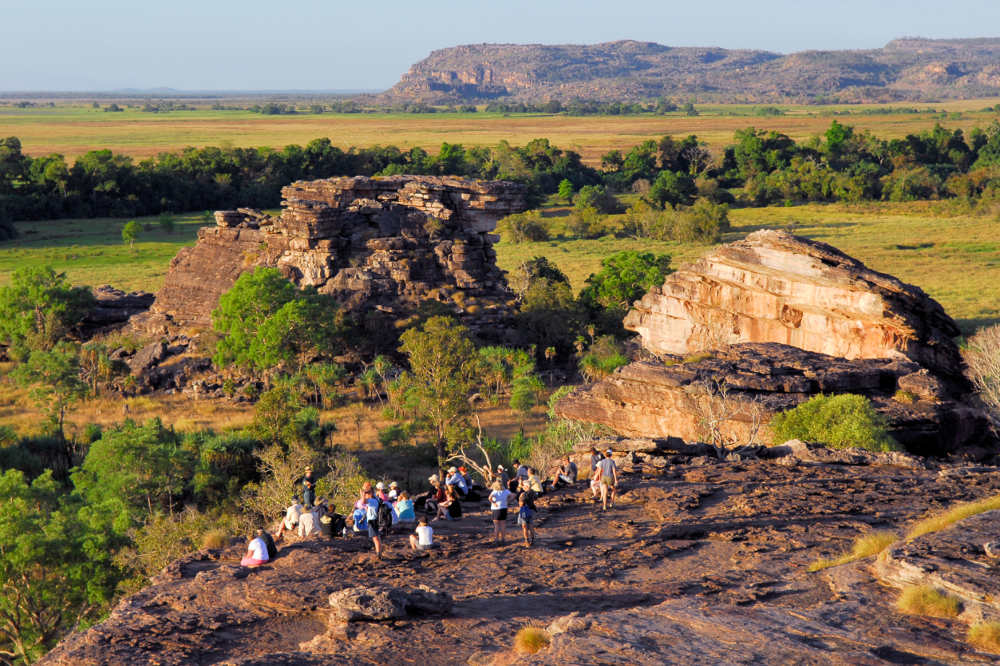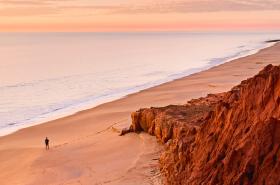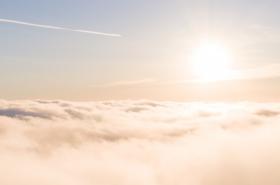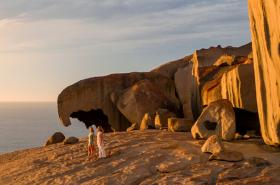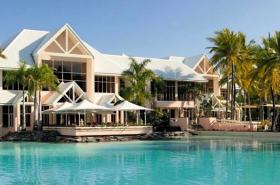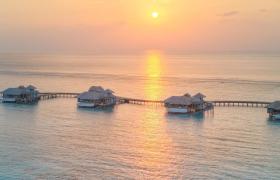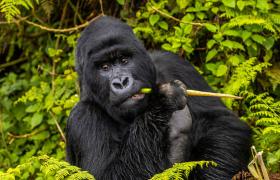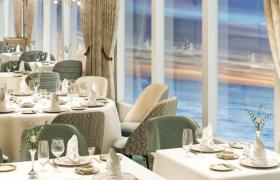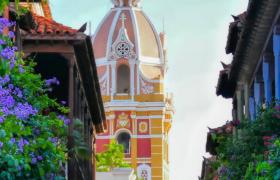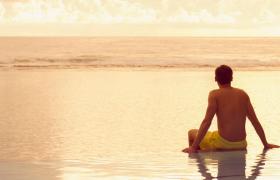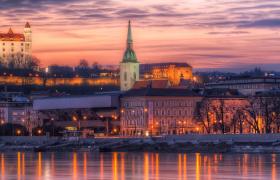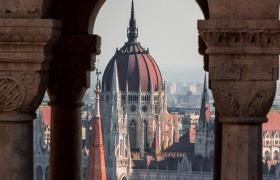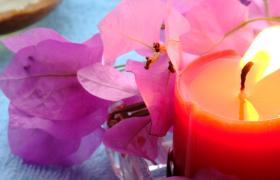It's 7.30am and our four-wheel-drive bus is heading towards the Northern Territory's wildest bushland, otherwise known as Kakadu national park. Most of the people on the bus are dozing but I'm up front with Nathan – driver, guide and enthusiastic naturalist – as he runs me through the wildlife we're likely to encounter on our trip: the spiders, the snakes, the scorpions.
There's a definite theme emerging, and I tell him I'm not sure I want to see anything that can poison or kill me. "Better walk around with your eyes closed, then," he snorts.
I wonder briefly if Nathan's old-fashioned Aussie bluntness is some kind of defence mechanism. The so-called Top End – the northernmost part of the Northern Territory – rarely makes it on to Australia's must-see lists, and I wonder if Nathan is, subconsciously, responding from pent-up frustration. Then the bus hits a dead snake, and someone spots a crocodile out of the window, and I realise that he probably has a point.
Top End tribulations
You've got to feel sorry for the Top End. Its capital and only city, Darwin, is situated just about as far from Sydney, Melbourne and Perth as you can be while remaining in Australia. And while it's blessed with the sort of beautiful coastline that proves such tourist bait for the rest of the country, its tropical landscape is also home to any number of biting, stinging creatures – including the box jellyfish, whose paralysing venom makes swimming in the ocean a death wish between October and May.
Considering that temperatures here average 28C all year round, the shimmering promise of the seashore feels like a vicious taunt. It doesn't help that the wet season, a period of unbearable humidity followed by torrents of monsoon rain, runs from September to March, ruining its appeal for Europeans seeking winter sun.
The result: Darwin tends to see few visitors apart from adventurous backpackers using it as a stop-off on their way to South-East Asia – a subset that perfectly describes my companions on this three-day bus 'safari'. That's a shame, because for ancient landscape, rare and colourful wildlife, and sheer breathtaking size, the Top End is home to some of the most impressive national parks in the world.
I've been a regular visitor to Darwin throughout my life, since my grandmother chose it as her unlikely home. I have spent many quiet days in its modest environs. Recently, however, the city has been making a noticeable effort to become more exciting to outsiders, and to showcase the natural beauties that surround it.
Lively Litchfield
Our first stop is Litchfield national park, a mere 90-minute drive south of Darwin, and a place where you can either hike for weeks or drop in on a day trip. Before I've had a chance to brace myself with a morning coffee, I find myself learning about the vicious, age-old war between the termites and the ants.
Litchfield's 'cathedral' termite mounds are one of the park's more unusual attractions: tall, Gaudi-esque structures that suggest killer aliens might just be gestating inside. We can't see the termites – they come out only at night – but Nathan assures us that they have soldiers ready to defend the mound against their bitter ant enemies: "They shoot acid out of their faces, which is pretty much the coolest thing."
A short walk away, what look like rows of ragged black gravestones are sticking up from the long grass as far as the eye can see: these are mounds built by magnetic termites. They face east-west to catch the sun, and create the eerie effect of a giant graveyard.
Not everything in the park is creepy or crawly, however. We come upon clusters of wallabies, and get close enough to see a joey pop his head from one mother's pouch.
We bathe in deep, clear rock pools watched by big-eyed geckoes and accompanied by a noisy chorus of frogs; we swim under dramatic waterfalls, where yellow-crested cockatoos and rainbow lorikeets streak the sky. Even a drive down the highway turns into a wildlife safari as we pass dingoes and feral cats, and a frill-necked lizard on his hind legs, looking for all the world like he's trying to hitch a lift.
Red Centre: Australia's Secret Wonderland
Boots on! Five Multi-Day Hiking Trails Across Australia
Into the wild: 10 Best Wilderness Holidays
Ancient Kakadu
Some 200 kilometres east of Darwin, Kakadu national park is to the Top End what Uluru is to the Red Centre. Its highly protected landscape belongs, both spiritually and legally, to the Aboriginal tribes of the area, who have lived here for 50,000 years.
At almost 20,000 square kilometres, it laughs in the face of most of the western world's designated wildernesses – even Death Valley, the largest US national park outside of Alaska, measures only 13,452 square kilometres. We have been driving through the park for more than an hour when I realise we've not yet passed another vehicle.
The occasional road sign offers directions to "Rockhole, 14" or "Shady Place, 35". Under our tyres, puddles and pockmarks splash the road's red mud liberally across the windows.
Outside, forests and floodplains come and go. Scraggy eucalyptus trees with their two-tone bark – black trunk, white branches – emerge from silvery lagoons; the undergrowth throbs with innumerable species.
The place feels positively primeval; Jurassic Park has never seemed such a real prospect. There's a good reason for this: Kakadu is officially ancient.
The cliffs that provide the most dramatic backdrop in the park, and which the locals call Stone Country, are not, as they appear, the remnants of mountains but one of the oldest exposed riverbeds in the world (1.8 million years old, to be precise). Aborigines took shelter among the stones, and created art here, painting and repainting the rock faces through hundreds of generations.
That rock art is on display at Ubirr, a sacred site deep in the park which has been opened, on a limited basis, to outsiders. While dream paintings, with their abstract combinations of dots and wavy lines, can seem rather impenetrable, the paintings at Ubirr are quite the opposite.
There are hunting pictures of turtles, barramundi and crocodiles, and narratives about spirits and men that served as warnings to children and others who might be tempted to do wrong. There's even a picture of an unusual figure with a strange second skin and a stick of fire emerging from his mouth – an early sighting of a pipe-smoking white man.
Rocks and rivers
Climbing the rocks brings us out on to a grand plateau; the sun shines on an epic panorama of vibrant greens. And rising ahead of us, a more modern totem, is the very rock, Nathan tells us proudly, that Paul Hogan stood on to make his 'telephone call' in the 1988 film Crocodile Dundee II.
Kakadu is large enough to have four separate ecosystems, from stone country and wetlands to floodplains and a form of rainforest whose trees aren't found anywhere else on earth. It also has a range of places to stay, from a luxury hotel built in the shape of a crocodile to the more basic permanent campsites that we've been put up in.
One of them offers a bushwalk, which a few brave souls decide to tackle at dusk; they come back with boots full of leeches, tales of enormous spiders, and an air of trauma. A late-night, snake-hunting trip in Nathan's company is rather less terrifying – we're safely in the bus, scanning the road with our headlights until we come across a carpet python, groggily digesting the large bump of rodent that forms a bulge about its middle.
But it's a trek in the monsoon rain next day that provides the biggest surprise. In the face of a tropical deluge that would have had Noah reaching for his hammer, Nathan's insistence on a six-kilometre walk to a "good spot for swimming" seems superfluous, and the looks on people's faces as we step out of the bus suggest that he's losing the battle for hearts and minds.
Fifteen minutes later, we're all sloshing through knee-deep puddles and discover that we're kind of enjoying it; by the time the sun comes out again an hour later, making the forest and its myriad caterpillars, dragonflies and grasshoppers gleam around us, we are transported. But when we reach the swimming spot, we find it's been cut off by a 15-metre-wide gush of murky brown floodwater that we couldn't cross even if we wanted to, and the swimming idea has to be abandoned.
"These are the exact conditions where you find the big saltwater crocodiles," explains Nathan. "And this is their hunting season."
Darwin delights
Crocodiles are everywhere in Darwin – on merchandise, and shopfronts, and on the highway, where businesses tout for attention with cheeky, grinning statues of 'salties'. There are crocodiles on the front page of the NT News, which revels in stories of sightings, attacks – and occasional deaths.
Tourists can watch them lunge at chickens on hooks at Darwin Crocodile Farm, where they are bred for their hides; you can see them snatch chickens off poles on a 'jumping croc' cruise on the Adelaide river, just south of town. You can even volunteer to spend time close to one in an underwater cage at the Crocosaurus Cove cage of death.
But as someone who remembers when the only non-crocodile-related entertainment in town was feeding time at the fish sanctuary, I'm impressed by how rapidly the city has changed. The Waterfront is a $A1.1 billion redevelopment of Darwin's former industrial port: here stinger nets across the entrance to the bay keep out the jellyfish; a wave pool caters for families with bodyboards; and a cluster of new restaurants and bars surround them.
The best of these is Il Lido, a contemporary wine bar at the base of the high-rise apartment blocks facing the lagoon. Now not only can you swim in the sea here for the first time, but you can get tapas, too.
In the centre of town, a courtyard of designer and vintage boutiques on the site of Star Village, Darwin's first cinema, has brought a touch of charm (and genuinely desirable products) to an otherwise moribund shopping centre. Mitchell Street, home to the town's backpacker population and daytime drinking culture, now sports a trendy espresso bar (although it's still best avoided in the evenings, when things can turn a bit punchy).
Darwin's best side, however, can be found a short drive north at Fannie Bay, where the sunsets are legendary, and the Museum and Art Gallery of the Northern Territory offers smart, intriguing displays of natural history and Aboriginal art, as well as a moving exhibition about Cyclone Tracy, the storm that flattened the city in 1974.
Next door is the Darwin Ski Club whose outdoor bar, with its plastic tables and chairs and easygoing atmosphere, is a welcome relief from the boisterous edge of Mitchell Street. Once I've tried the kitchen's kangaroo fillet and pan-fried barra, I know I've found a rare Darwin gem and I linger on long after the sun has performed its dramatic descent into the sea.
Melting pot
There's a sub-plot to the city's transformation: it involves the construction of a huge Japanese-funded natural gas processing plant. Money is now washing into the area, and an unprecedented influx of young workers has forced on the city a sophistication that never existed before. Darwin has always been a city of immigrants – the Chinese and Indonesians were trading in these parts long before the Europeans arrived – but when I check in to the Mantra on the Esplanade hotel, I'm struck anew by the city's quiet cosmopolitanism; the staff, friendly to a fault, are from Thailand, Tonga, The Philippines, Denmark.
It's a melting pot characterised in the city's food scene. Well, 'food scene' may be too strong a term for a city whose best restaurants close for long periods during the wet season, but there is certainly an increasing respect for, and showcasing of, the community's Pacific straits flavours, specifically the Chinese-Malaysian cuisine known as Nonya. Hanuman, a Thai and Nonya joint on Mitchell Street that is easily the smartest in town, is packed with locals on the Sunday night I visit – and one taste of its satay is enough to tell you why.
But you don't have to fine dine to enjoy the local flavours – the Saturday markets at Parap and Nightcliff are full of stalls selling laksa, delicious bowls of broth and noodles, accompanied – if you wish – by breathtakingly hot sauce.
Back out in Kakadu, where 'communities' such as South Alligator and Corroboree are nothing more than petrol stations with bars attached, the options are rather more limited. On our final night at camp, we barbecue some chicken sausages before turning in.
There's an option to sleep out in swags, under the Territory's incredible canopy of stars. This is a popular choice in the dry season but not today, when the atmosphere is 100 per cent water.
There are mosquitoes, for sure, and there are snakes and spiders out there in the dark, and if you don't wear boots you deserve all the leech bites you get. But I wouldn't want to experience this incredible, ancient bushland any other way.
This article originally appeared on guardian.co.uk
This article was written by Emma John from The Guardian and was legally licensed through the NewsCred publisher network.

